
“Seeds drifting through space for years took root in a farmer’s field. From the seeds came pods which had the power to reproduce themselves…” – Dr. Miles J. Bennell | Invasion of the Body Snatchers, 1956
They’re already here! They’re growing silently in your favorite parks. They’re climbing over trees, covering the forest floor, and slowly taking over the ecosystem–vine by vine, sprout by sprout! They’re leafy invaders from outer space and they’re hiding in plain sight!
Well, technically, they aren’t from outer space and they certainly aren’t going to turn you into a pod person. The aliens we worry about at Rock Creek Conservancy come from all over planet Earth, and are a major problem for the forests of Rock Creek Park. Today, we’re talking about invasive plants.
The extraterrestrials from the 1955 sci-fi novel The Body Snatchers planned to leave Earth depleted of all resources before moving on to the next planet. Similarly, the non-native invasive plants that take root in Rock Creek Park wreak havoc on entire ecosystems. They monopolize space, nutrients, and sunlight until the local flora and fauna can’t live here anymore.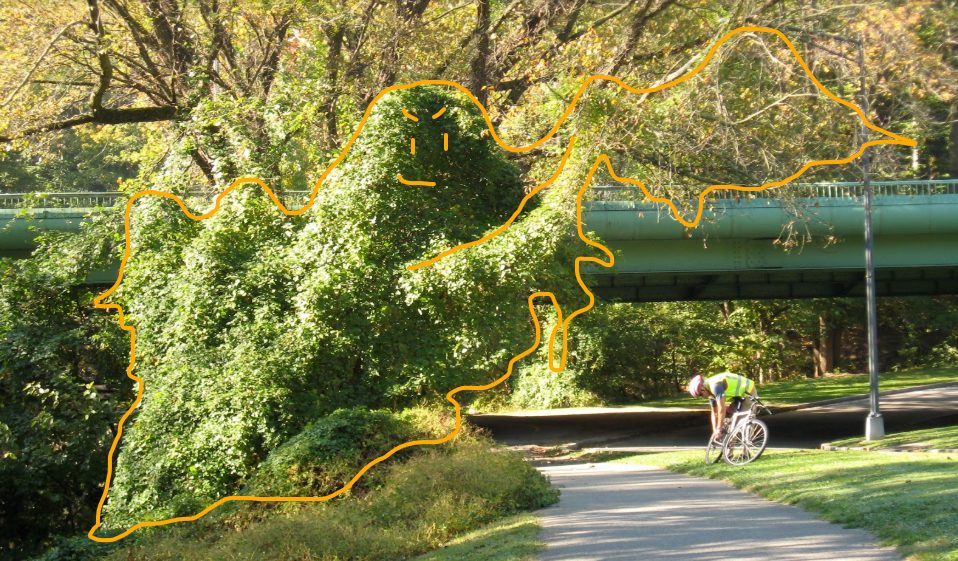
Monster from another planet or invasive plant? Invasive porcelain berry looms over a pedestrian pathway as it grows over a tree in Rock Creek Park. Credit: Rock Creek Conservancy
This year, Rock Creek Conservancy is working in five areas called mini-oasis restoration sites to stop these earthly invaders. The goal is to get these areas to less than 5% invasive plant coverage by the year 2020.
We’re well on our way to that 5% goal, but we need your help! To do that, you need to be able to I.D. these photosynthetic strangers. You’re probably familiar with English ivy, which is incredibly common in gardens and leads to the death of many trees in Rock Creek Park every year. However, like the alien doppelgängers from Invasion of the Body Snatchers, not all invasive plants are so easy to spot. Below we have listed three common invasive plants and their native doubles that live in Rock Creek Park.
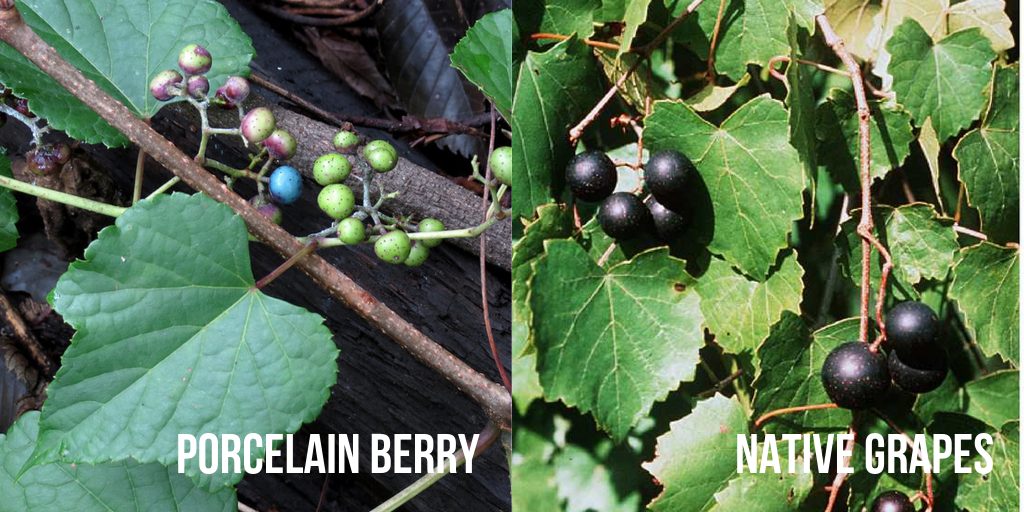
Credit: Porcelain berry (Ampelopsis brevipedunculata) – Katja Schulz; Native Grapes (Vitis rotundifolia) – Carl Hunter via the USDA-NRCS PLANTS Database
“Seeds drifting through space for years took root in a farmer’s field. From the seeds came pods which had the power to reproduce themselves…” – Dr. Miles J. Bennell | Invasion of the Body Snatchers, 1956
They’re already here! They’re growing silently in your favorite parks. They’re climbing over trees, covering the forest floor, and slowly taking over the ecosystem–vine by vine, sprout by sprout! They’re leafy invaders from outer space and they’re hiding in plain sight!
Well, technically, they aren’t from outer space and they certainly aren’t going to turn you into a pod person. The aliens we worry about at Rock Creek Conservancy come from all over planet Earth, and are a major problem for the forests of Rock Creek Park. Today, we’re talking about invasive plants.
The extraterrestrials from the 1955 sci-fi novel The Body Snatchers planned to leave Earth depleted of all resources before moving on to the next planet. Similarly, the non-native invasive plants that take root in Rock Creek Park wreak havoc on entire ecosystems. They monopolize space, nutrients, and sunlight until the local flora and fauna can’t live here anymore.
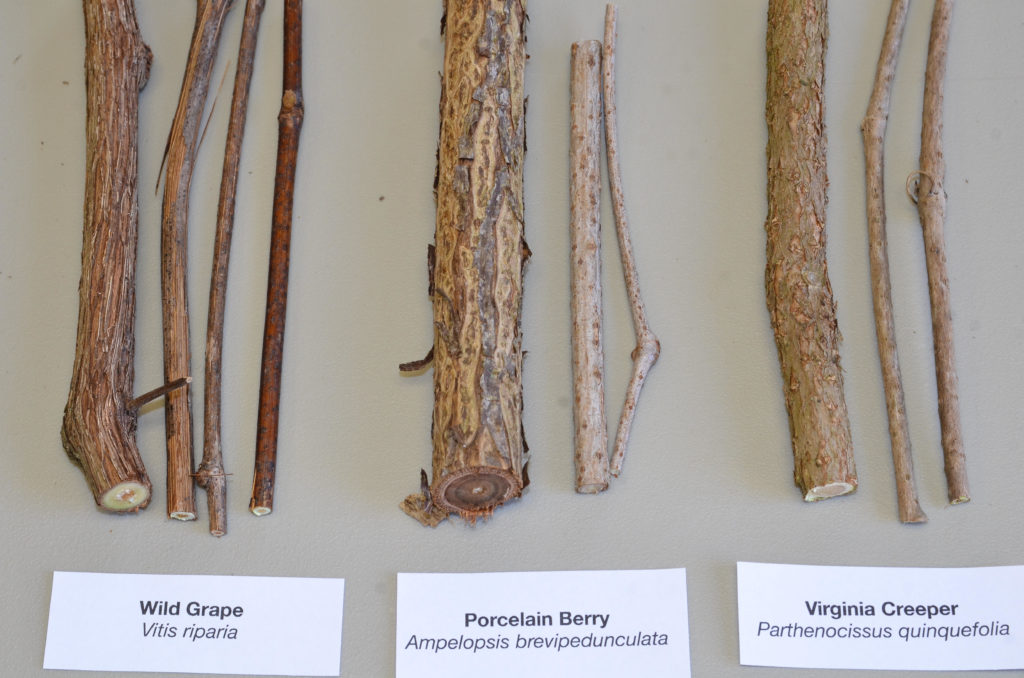
One of the easiest ways to tell these plants apart is the texture of their bark. The bark of native grapes peels off in strips while porcelain berry is smooth by comparison. Credit: Frank Hassler, Good Oak Ecological Services
To tell them apart, first look at the bark of the vine. Porcelain berry vines are smooth whereas native grapevines peel off in strips. If it’s berry season, check to see if the fruit is growing upwards or hanging down. Porcelain berries are bright blue and they tend to grow up from the vine; native grapes are green, dark purple or black and hang down from the vine. Finally, turn a leaf over and look for hair. Porcelain berry leaves have hair only on the veins of the leaf. Native grapes usually have hair on the leaf surface, perhaps along the veins but never directly on them.
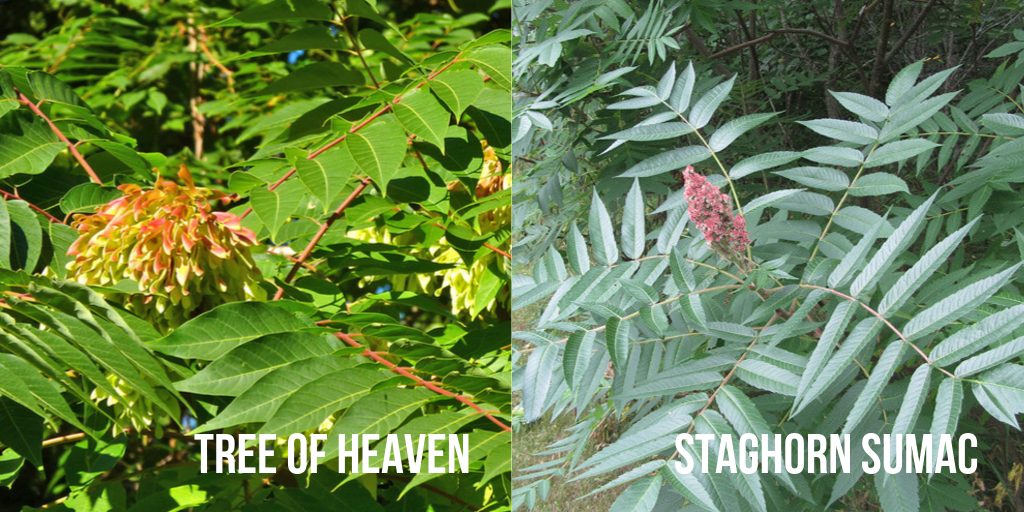
Credit: Tree of heaven (Ailanthus altissima) – NatureServe; staghorn sumac (Rhus typhina) – Homer Edward Price
Tree of heaven (Ailanthus altissima) was introduced to North America all the way back in 1784 and has been thriving ever since. You may know this tree from its star role in the book A Tree Grows in Brooklyn, where its ability to grow anywhere inspires many a reader to this day. Despite being a metaphor for tenacity and the betterment of one’s life, this tree is not bettering our ecosystem. It crowds out Rock Creek’s local plants with ease by growing fast, spreading more than 300,000 seeds per season, and releasing chemicals from its roots that stop other plants from sprouting nearby.
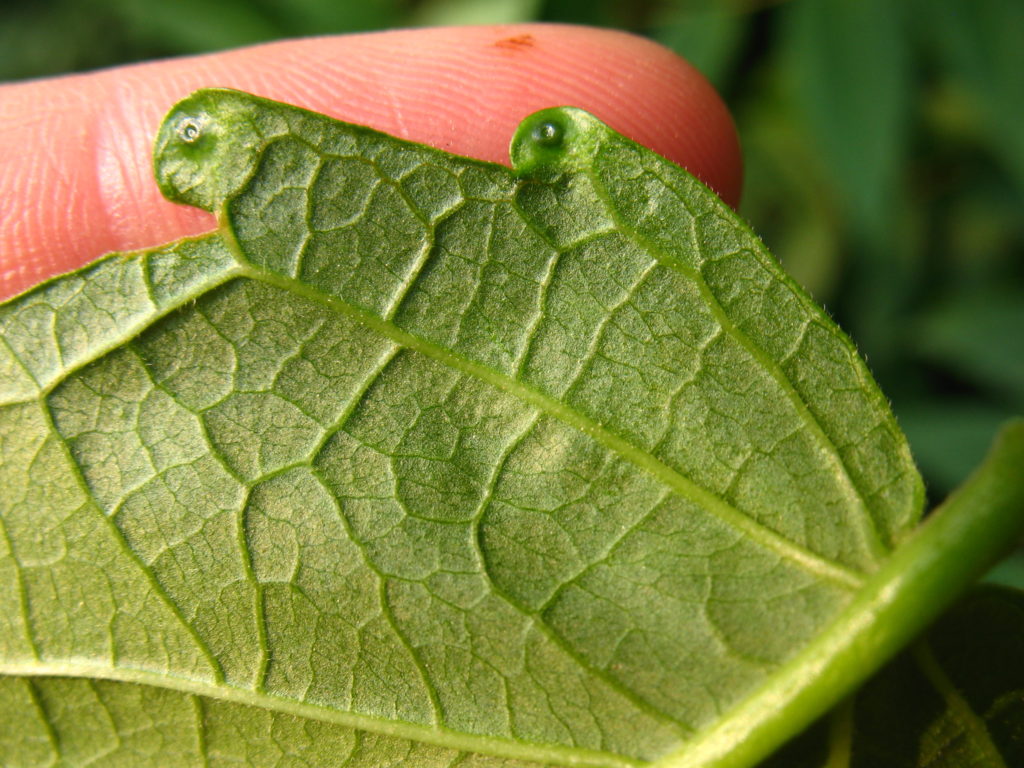
The tree of heaven can be distinguished from similar plants by the small circular glands on the underside of each leaf. Credit: Vilseskogen
The compound leaves of the tree of heaven are easily mistaken for several natives including staghorn sumac (Rhus typhina). One way to tell them apart is their leaves. Sumacs have serrated leaflets, contrasting with the smooth leaflets of the tree of heaven. In addition, the tree of heaven has a shallow lobe near the base of each leaflet. Turn the leaf over and you will see a small circular gland on this lobe. This feature is unique to the tree of heaven. It is easier to tell these plants apart in the fall and winter when sumacs grow beautiful bright red clusters of hairy fruit, which are essential winter food for many native birds.
Still, our favorite way to identify a tree of heaven is by smell. Crush a small piece of the leaf in your hand and you will be treated to the tree’s unique “burnt peanut butter” smell.
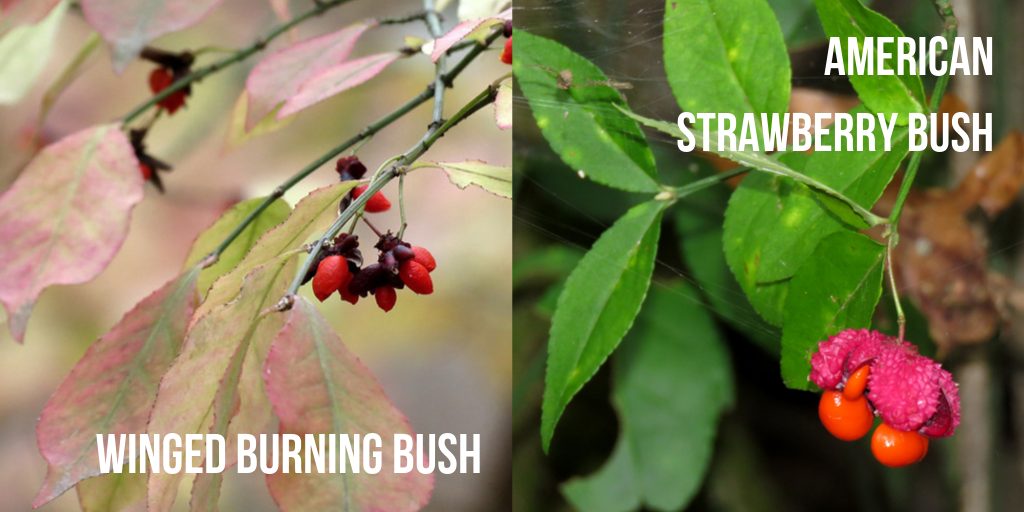
Winged burning bush (Euonymous alatus) and American strawberry bush (Euonymous americanus) Credit: Katja Schulz
Winged burning bush (Euonymous alatus) is a deciduous shrub that has long been prized as an ornamental plant because of its bright red fall foliage. They are new to the invasive plant scene, having first been spotted in the wild in the 1960s. The species loves the shade, which means it can take over the forest understory in even mature forests. You can see this at our Trail #9 Mini Oasis, where we have removed 145 of these shrubs over the past year.
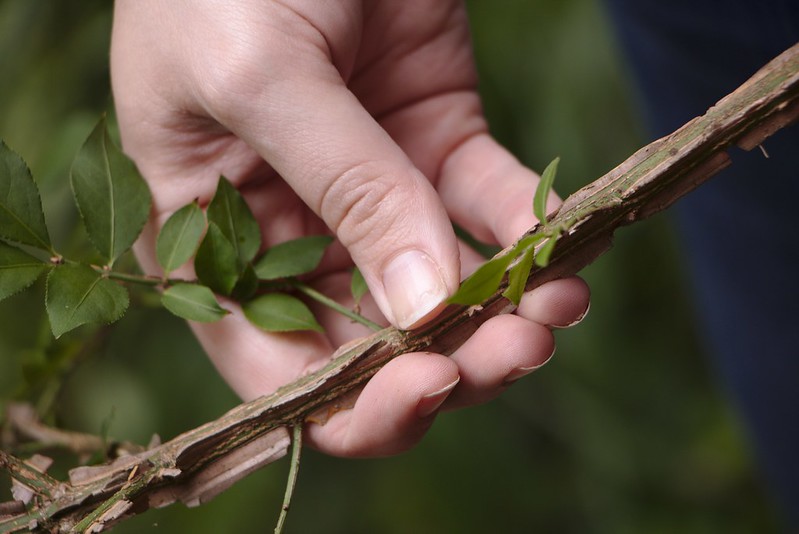
Winged burning bush has four distinctive ridges (or wings) that run along the branches of the plant. Credit: Diana Lu
The plant looks strikingly similar to its native cousin–the strawberry bush (Euonymous americanus)–which grows naturally in Rock Creek Park. There are two simple ways to tell these plants apart. The first sign is also the namesake of the winged burning bush–the wings! Each branch of the invasive shrub has flat “wings” that run laterally up and down the stem.
If you’re out this fall, you can also look at the fruit. Both plants have hard capsules that open to reveal a soft fruit inside that birds love. The winged burning bush has a smooth, purple fruit capsule that turns brown and opens to reveal two red berries. Meanwhile, the strawberry bush (also called “Hearts-a-Bustin”) has a crimson, spiky fruit capsule that opens to reveal five soft orange berries.
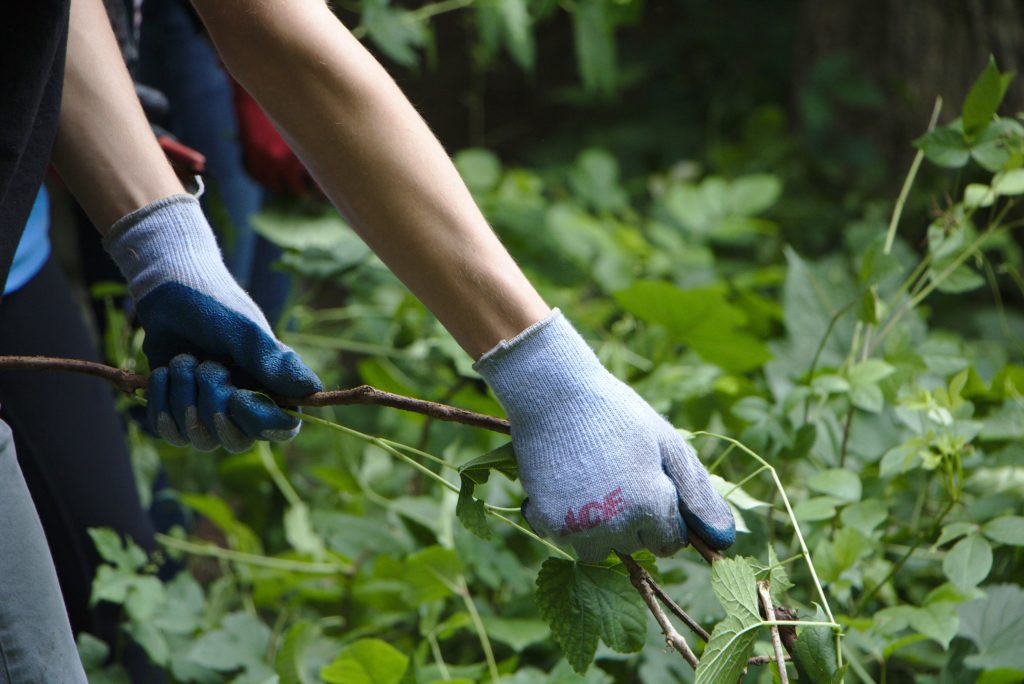
Volunteers remove invasive porcelain berry from the Trail 9 Mini-Oasis in Rock Creek Park. Credit: Diana Lu
“Listen to me! Please listen! If you don’t, if you won’t, if you fail to understand, then the same incredible terror that’s menacing me WILL STRIKE AT YOU!” – Dr. Miles J. Bennell | Invasion of the Body Snatchers, 1956
The ending of the 1956 movie Invasion of the Body Snatchers leaves us wondering if humanity can prevail. In truth, invasive plant removal can sometimes feel the same way. These plants grow so fast that we may never fully get rid of them once they are established. However, Rock Creek Conservancy has a strategy to manage these invaders, and it will only succeed with the support of park friends and neighbors.
All three of these virulent invaders started as ornamental garden greenery. Keep invasive plants from spreading by removing them from your home and garden–or don’t plant them in the first place! There are many beautiful native plants that you can substitute, which have the added benefit of providing native wildlife with food and shelter. Encourage your community members to do the same! You can view a full list of common invasive plants in Rock Creek here.
Rock Creek Park is managed by the National Park Service, so you can’t simply stroll in and start picking plants. To remove plants from the parks you love, you’ll have to volunteer with us at Rock Creek Conservancy. Or you can volunteer to become a trained Weed Warrior, learn all about invasive plants and remove them on your own time. Find upcoming volunteer events and other events in Rock Creek Park here.
You can also use the app iNaturalst to log where you see invasive plants when you’re out and about. This crowdsourced ecological data is often used by local natural resource managers to identify areas that need action.
Sources
https://extension.psu.edu/
https://caseytrees.org/2014/
https://www.nybg.org/files/
Recent Stories

Photo by Tim Brown Ed. Note: If this was you, please email [email protected] so I can put you in touch with OP. “Dear PoPville, I had a guy ask me…

We’re about a month out from summer. That means you’ve still got time for spring cleaning!
Lexi Grant, an operations manager at Well-Paid Maids, shared her go-to spring cleaning tips with WTOP News. Step one? Declutter. Get rid of items you don’t use, find space for items that need a home and organize those areas.
Then, it’s time to dust. Lexi starts with high-touch surface areas (think: refrigerator, dishwasher, counters, microwave). One area she sees often neglected is the bedroom — and it makes sense. Heavy furniture is difficult to move around, but it’s important to really get in there so dust doesn’t affect your sleep.

In Commemoration of the 100th Anniversary of the Passing of Giacomo Puccini
The Washington Opera Society Presents
Giacomo Puccini’s “La Fanciulla del West”
Featuring: Jonathan Burton, Michael Butler, Kristin Sampson, Kevin Short, with Adam Cioffari, Andrew Boivert, Peter Burroughs, Collin Power, Josh Bates, Carl Rosenthal, Jude Regan, Jose Sacin, Solomon Collins, Anamer Castrello, Noah Mond, and Maestro Julian Benichou conducting the Chorus & Orchestra of the Washington Opera Society.
Baker Meet Up: Baking With Local Rye
Calling all home bakers and professional bakers alike! CGA is hosting its next Baker Meet Up on Monday, June 3 from 6-8 p.m. at the University of the District of Columbia. This time around, we’re focusing on baking with local
Beyond Boundaries: An Evening Curated by Annabelle Lopez Ochoa
May 22-25 at 8pm
May 25-26 at 2pm
Internationally acclaimed choreographer Annabelle Lopez Ochoa curates a special evening, including her lauded 2019 TWB commission, Delusional Beauty. Works from emerging choreographers, Chanel Da Silva and Houston Thomas will elevate diverse voices






